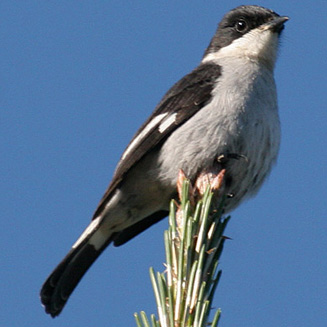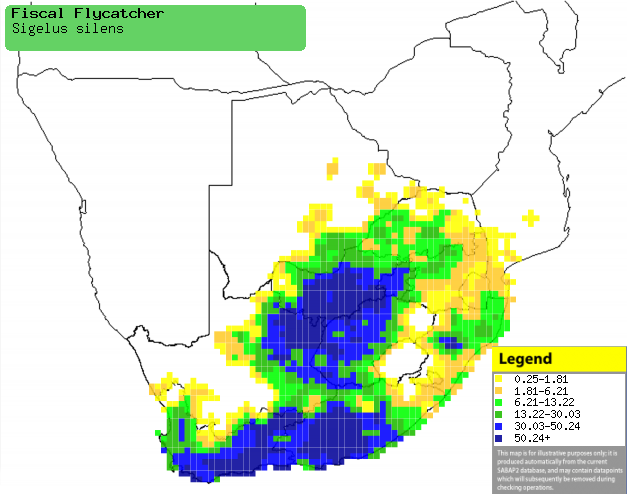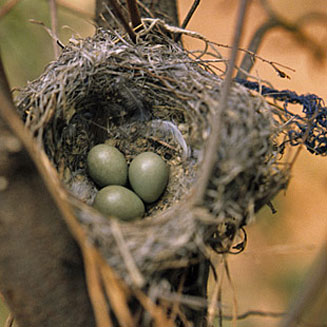|
Sigelus silens (Fiscal flycatcher)
Fiskaalvlieëvanger [Afrikaans]; Icola [Xhosa]; Klauwiervliegenvanger
[Dutch]; Gobemouche fiscal [French]; Würgerschnäpper [German];
Papa-moscas-fiscal [Portuguese]
Life
> Eukaryotes >
Opisthokonta
> Metazoa (animals) >
Bilateria >
Deuterostomia > Chordata >
Craniata > Vertebrata (vertebrates) > Gnathostomata (jawed
vertebrates) > Teleostomi (teleost fish) > Osteichthyes (bony fish) > Class:
Sarcopterygii (lobe-finned
fish) > Stegocephalia (terrestrial
vertebrates) > Tetrapoda
(four-legged vertebrates) > Reptiliomorpha > Amniota >
Reptilia (reptiles) >
Romeriida > Diapsida > Archosauromorpha > Archosauria >
Dinosauria
(dinosaurs) > Saurischia > Theropoda (bipedal predatory dinosaurs) >
Coelurosauria > Maniraptora > Aves
(birds) > Order: Passeriformes
> Family: Muscicapidae
 |
 |
| Fiscal flycatcher, South Africa. [photo
Jim Scarff ©] |
Fiscal flycatcher, Karoo National Park, South
Africa. [photo Trevor Hardaker ©] |
Distribution and habitat
Endemic to southern Africa, occurring from south-eastern
Botswana and the extreme south of Mozambique to Swaziland and South Africa. It
generally favours open habitats with scattered trees or bushes to use as perches,
such as moist and semi-arid grassland, fynbos, Nama Karoo, valley bushveld,
scrub Acacia and kloof bush in highveld. It is most common in ecotones
between two habitats; one with fairly dense thicket used for nesting and another
with large patches of open ground for foraging.
|
 |
|
Distribution of Fiscal flycatcher in southern Africa,
based on statistical smoothing of the records from first SA Bird Atlas
Project (©
Animal Demography unit, University of
Cape Town; smoothing by Birgit Erni and Francesca Little). Colours range
from dark blue (most common) through to yellow (least common).
See here for the latest distribution
from the SABAP2. |
Predators and parasites
Brood parasites
It has been recorded as host of the
Jacobin cuckoo.
Movements and migrations
Resident in most of areas of its distribution,
although it only occurs in central Botswana in winter.
Food
It mainly eats small insects supplemented with fruit, doing
most of its foraging from a high perch, pouncing on prey on the ground and
occasionally hawking prey aerially. It may occasionally be seen in large
mixed-species foraging flocks, especially at termite alate emergences and where
there are half asleep (torpid) ants on the ground. The following food items have been recorded
in its diet:
- Invertebrates
- Insects
- Hodotermes mossambicus (Northern harvester termite)
- ants
- grasshoppers (Orthoptera)
- Imbrasia cytherea (Emperor pine moth)
- earthworms
-
Hemiptera (bugs)
- Plants
- nectar of Aloe marlothii (Mountain aloe)
- fruit
- Euonymus (spindle tree)
- Cotoneaster pannosus (cotoneaster)
- Morus alba (Mulberry)
- Halleria lucida (Tree-fuchsia)
- Chrysanthemoides monilifera (Bushtick-berry)
- Miscellaneous
- porridge from dog bowl
- bonemeal from bird feeder
- fledgling Motacilla capensis
(Cape wagtail)
Breeding
- The nest (see image below) is built solely by the female, consisting of a
bulky, open cup built of stems of dry grass combined with other plants such
as everlastings (Helichrysum) and slangbos (Stoebe), as well
as string and rags if the nest is near urban areas. The interior is usually
thickly lined with material such as soft plant down, feathers, rootlets,
Galium tomentosum (Old man's beard), wool, fine grass and hair, in fact
there is a record of a Fiscal flycatcher attempting to pluck hair from a
person's head! It is typically placed in a thick forked branch, on a branch
adjacent to a tree trunk, among dead aloe leaves, inside a dead stump or
branch.
 |
|
|
Fiscal flycatcher nest with eggs, Christiana,
South Africa. [photo Warwick Tarboton ©] |
|
- Egg-laying season is from about July-February, peaking around
October-December.
- It lays 2-4 eggs, which are incubated solely by the female for about
13-16 days, all the while being fed by the male. It often leaves the nest
for long periods, rendering it vulnerable to predation, in fact a
Common fiscal was once
recorded fighting with the Fiscal flycatchers.
- The chicks are fed solely by the female, while the male takes little
interest, leaving the nest after about 15-17 days. The fledglings are still
fed by their parents after leaving the nest; strangely a
Cape robin-chat was once found feeding
beetle larvae to the fledglings, hiding when their parents approached.
Threats
Not threatened.
References
-
Hockey PAR, Dean WRJ and Ryan PG 2005. Roberts
- Birds of southern Africa, VIIth ed. The Trustees of the John Voelcker
Bird Book Fund, Cape Town.
|
